The aim of the work is to study the effects of different treatments: control, single application of organic manure, two seasons straw returning, a quarter of straw returning combined with nitrogen fertilizer, two seasons straw returning combined with nitrogen fertilizer on the quality index and yield of summer maize; protein, starch, fat content and the amino acid were analyzed using cluster analysis. The results showed that there are significant effects of different fertilization on the quality and yield of maize; the content of maize grain protein content of different straw returning treatments significantly increased by 0.90, 77.03 and 60.6% respectively which was higher than other test treatments. In addition, single organic fertilizer has the most prominent effect on total amino acids. However, the amounts of starch decreased and the less decreased treatment was a quarter of straw returning combined with nitrogen fertilizer treatment for 3.5%. The highest crude fat of grain of the single application of organic manure (M) significantly improved by 24.79%. The results show that different long-term straw and fertilizer affect summer maize in their quality characters; application of organic fertilizer can significantly improve the quality of summer maize, as well as its protein and amino acid content.
With the continuous improvement of people's living standards, the requirement of quality of crop products is also increasing. The quality of crops is affected by the dual influence of genetic, ecology environment and cultivation technology (Sun et al., 2011). Fertilization is the most important factor affecting the quality of crops, because it is the most direct source of nutrients. Long term positioning of straw returning to field has great meaning in the study of fertilization, soil fertility, environmental evolution, variation of crop yield and quality, and is valued domestically and overseas (Zhao and Zhang, 2002; Gao et al., 2015; Belay et. al., 2002; Wang et al., 2015; Wang et al., 2001) . In the past, the research on the quality influence of crops is relatively weak, because the research fields of different fertilization systems on the long-term positioning mostly focused on the effects of soil fertility and yield.
Previous researches mainly study the effect of short term fertilization on the quality of maize (Gao et al., 2015; Bao, 2000; Li et al., 2017; Qu et al., 2002; Xiao et al., 2016; Montemurro et al., 2002). This experiment determines and analyzes the content of crude fat, protein, starch and amino acids of maize samples through long-term straw returning treatments. We studied the effect of the quality of corn straw returning treatments and provide a theoretical basis for rational fertilization (Lan et al., 2012; Li et al., 2017; Lu and Lu, 2017). Long-term fertilization experiment of straw returning is a test method of "long term" and "positioning". It is secular and has the characteristics of repetition in the climate, abundant information, accurate and reliable, strong explanatory power and can provide decision-making basis for the development of agriculture.
Therefore, it has inimitable advantages compared to routine testing (Gao et al., 2015; Xiao et al., 2016). So it can solve the scientific problems that cannot be solved by many short-term tests. At present, our country is facing the problem of "food security", which determines in the future, the influence of long-term fertilization on crop yield, quality and soil fertility and soil quality. It is still the main content of China's long-term fertilization trial (Gao et al., 2015; Huang et al., 2010). This paper built on the long-term orientation of straw returning to field experiment, the effects of different straw returning treatments on the quality of summer maize, and provided the basis for scientific and reasonable fertilization (Cui et al., 2017; Dickson et al., 2013; Hana et al., 2010).
Experiment design
The experiment was built up in Laiyang Test Station (36.9°N, 120.7°E) of Qingdao Agricultural University in 2009. It is Gleyic Cambisols and the basic properties are as follows: 6.8 pH; 5.01 g/kg Soil Organic Matter (SOC); 0.60 g/kg Total Nitrogen (TN); 0.64 g/kg total phosphorus (total P); 16.34 mg/kg Olsen P; 72.00 mg/kg Available Potassium (AK) and 13.80 cmol/kg Cation Exchange Capacity (CEC). The rotation of wheat and maize were in the autumn and summer every year. There were five treatments in this study (Table 1): A quarter of straw returning combined with application of nitrogen fertilizer (WN), two seasons straw returning (WC), two seasons straw returning combined with nitrogen fertilizer (WCN), single organic manure (M) and blank control of no-fertilizer (CK). Each treatment has 3 replicates, with plot area of 33.3 m2; the random group was arranged.

The rotation of winter wheat and summer corn was in autumn and summer every year. The type of wheat was Yanyou361. In addition, the type of corn was Luyu 16. Urea was used for inorganic fertilizer, and high amount of nitrogen fertilizer (276 kg/hm2) was applied per year. Pig manure was used for organic fertilizer and nitrogen content of 2-3 g/kg; total phosphorus content of 0.5 to 2 g/kg, organic matter content of 20 to 50 g/kg. Corn and wheat straw returned to field totally. Organic fertilizer was used as basal fertilizer overall, and for tilling of the soil before wheat planting in winter. Nitrogen fertilizer is used for seed manure, topdressing of turning green and jointing stage of wheat, topdressing of jointing stage and bell stage of maize. 45 kg/hm2 seed fertilizer of urea was applied per year. The rest is used as topdressing of turning green and jointing stage of wheat (furrow fertilization); topdressing of jointing stage and bell stage of summer maize (hole fertilization).
Experiment method
The summer maize samples were protected by paper bags in the field and samples in 2009 to 2014 were used in this study. In each plot, 30 samples were randomly collected and 25% samples were kept on average. All the samples were sieved to 0.25 mm. The contents of protein of the wheat were investigated Jiacheng Lao (Lao et al., 1998. Analysis of Soil Chemistry Handbook): “Micro kjeldahl determination”. The starch was determined by anthranone-H2SO4 and fat was tested by residue method, but the amino acid was analyzed by automatic amino-acid analyzer. Protein components were determined by coomassie brilliant blue G - 250 method. All the data were analyzed by SPSS 19.0.
Effect of long term positioning of straw returning on the protein content of summer maize grain
The effect of long term positioning of straw returning on the protein content of maize grain was shown in Figure 1. Compared with the control, the content of maize grain protein content of different straw returning treatments (WC and WCN, WN) significantly increased by 0.90, 77.03 and 60.6% respectively; and compared to organic fertilizer, two seasons straw returning combined with nitrogen fertilizer made protein content of maize grain significantly increased by 7.22%. Under the same nitrogen fertilizer level, the protein content of maize grain of the two seasons straw returning treatment (WCN) was significantly higher than a quarter of straw returning(WN), WCN processing maize grain protein content significantly increased by 10.37%; under the same straw returning to the field level, the content of protein of maize grain of nitrogen fertilizer treatment (WCN) was significantly higher than straw returning treatment (WC) and WCN processing significantly increased by 72.44%.
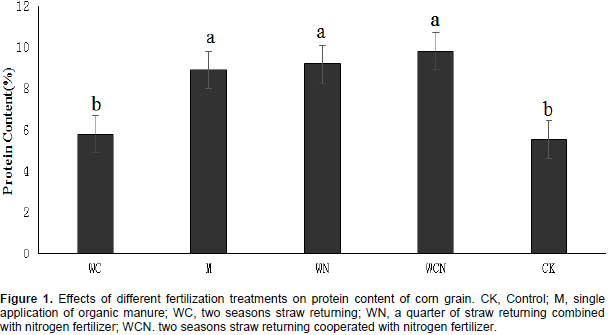
High proportion of nitrogen was beneficial to the increase of protein content in maize grain. With the increase of the amount of straw returning, the protein content increased within certain range, consistent with the Theory of Nutrient Returns. The results showed that the different fertilization treatments can affect the content of protein in summer maize. Single straw returning treatment had minor effect on protein content, two seasons straw returning combined with nitrogen fertilizer on corn protein content increased significantly. It showed that the straw fertilizer combined with nitrogen fertilizer could promote nitrogen uptake, thereby affecting protein synthesis and enhancing the corn quality through increasing protein content. Therefore, nitrogen fertilizer and organic fertilizer and straw returning can effectively improve the content of protein in maize grain, and effectively improve the quality of maize grain (Li et al., 2015).
Effect of long term positioning of straw returning on the crude fat content of summer maize grain
There are differences in crude fat content of corn grain between different straw returning treatments (Figure 2). Compared with the control, the crude fat of grain of the single application of organic manure (M) significantly improved by 24.79%, the straw returning treatment combined with nitrogen fertilizer compared with organic fertilizer, summer maize grain crude fat content were significantly reduced by 8.51 and 16.44% of two seasons straw returning combined with nitrogen fertilizer (WCN) and a quarter of straw returning combined with nitrogen fertilizer (WN) respectively. Under the same nitrogen fertilizer level, straw returning in two seasons (WCN) crude fat content was significantly higher than a quarter of straw returning(WN) treatment and it significantly increased by 9.49%.
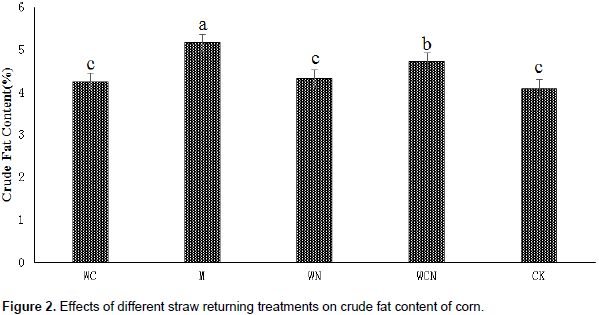
It suggested that high proportion of straw returning can be beneficial to improve the crude fat content of corn grain. Overall results indicated that the effect of straw returning and fertilization on maize grain crude fat content was significant, single application of organic fertilizer could significantly increase the content of crude fat in corn, straw returning and nitrogen fertilizer combined application made the content of crude fat decreased slightly. It was possible because straw and nitrogen fertilizer combined application affects the synthesis and accumulation of crude fat; therefore, if we want to improve the content of crude fat of corn, we should increase the application of organic fertilizer, or straw and nitrogen and increase organic fertilizer (Chen et al., 2012).
Effect of long term positioning of straw returning on the starch fat content of summer maize grain
As Figure 3 shows, and compared with the control, the starch content of maize grain of single application of organic manure treatment (M) significantly increased by 10.67%; and compared to M treatment, straw returning combined with nitrogen fertilizer made corn starch content decreased significantly. Among them, the decreasing amplitude of two seasons straw returning combined with nitrogen fertilizer (WCN), and a quarter of straw returning combined with straw returning (WN) were 18.74 and 24.53% respectively; under the same nitrogen fertilizer level, starch content of one season of straw returning treatment (WN) was significantly higher than the two seasons straw (WCN) processing . The maize starch content of WN processing improved by 8.58% compared to the WCN processing. In the same amount of straw returning to field (WC and WCN), the WC treatment significantly improved by 19.52% compared to WCN treatment; high proportion of straw returning to field was more favorable to increase grain starch content.
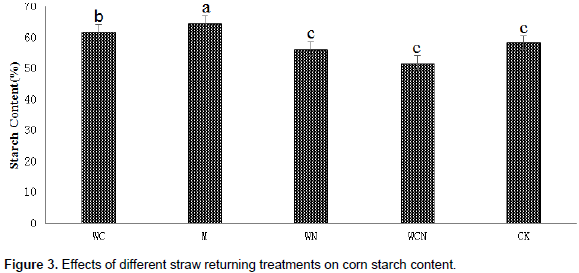
Test results show that there are significant differences between the different treatments. The content of starch in the control group was higher than straw returning and straw returning combined with nitrogen fertilizer application treatment. WCN and WN reduced by 11.1 and 3.5% than the control respectively. The starch content in the treatment reduction is possibly attributed to large planting density of blank processing, sunlight relatively strength, the plant carbohydrate synthesis increase, that results in increase of the starch content. Nitrogen fertilizer led to the imbalance of soil nutrient, which affected the synthesis of carbohydrate. So, the accumulation of starch in maize kernel is reduced, as well as the grain quality of maize.
Effect of long term positioning of straw returning on the amino acid content of summer maize grain
As Table 2 shows, amino acid content of five treatments and a quarter straw returning combined with nitrogen fertilizer treatment (WN) was 6.52% at most, followed by two seasons straw returning combined with nitrogen treatment (WCN) (6.34%). The control treatment (CK) has a minimum value of 4.10%; and in five experimental treatments, the content of glutamic acid was the highest among 14 kinds of amino acid. In the control treatment(CK), single application of organic manure (M), two seasons straw returning (WC), a quarter straw returning combined with nitrogen (WN), two seasons straw returning combined with nitrogen fertilizer (WCN), the glutamic acid content of five treatments was 0.71, 1.39, 0.78, 1.23 and 1.19% respectively. Among these treatments, the glutamate content from single application of organic fertilizer processing(M) was the highest (1.39%), followed by a quarter of straw returning combined with nitrogen treatment (WN) (1.23%), and control group treatment with a minimum of 0.71%.

Compared with the control, the glutamate levels of a quarter straw returning combined with nitrogen treatment (WN) and two seasons straw returning combined with nitrogen treatment (WCN) increased by 95.77 and 73.24% respectively; under the same nitrogen fertilizer input level, WC treatment compared with the WCN treatment, the content of glutamic acid reduced by 34.45%. Other kinds of amino acids in WC processing in respect to the WCN treatment also showed a downward trend. It suggests that nitrogen fertilizer with plenty of straw returning could significantly increase the content of amino acids of maize grains. There are increased total amino acids and essential amino acids in different straw returning treatments. Single organic fertilizer changed most significantly.
It suggests that single organic fertilizer has the most effect on total amino acids; different long-term straw returning treatments have different effect on the contents of various amino acids in summer maize, a quarter straw returning combined with nitrogen treatment (WN) has remarkable influence on serine, glutamic acid, isoleucine, leucine, tyrosine, phenylalanine and proline of summer maize, and different treatments have different effects on the amino acid. The effect of long-term straw returning on amino acid content of maize grain is shown in Figure 4. The change trend of total amino acid content is in line with the content of protein. Q clustering hierarchical of SPSS was used to analyzed amino acid content respectively. Individual distance used was squared Euclidean distance. The distance between classes adopts average linkage distance, and the clustering analysis tree was created finally. As shown in Figure 4, the contents of amino acid of a quarter of straw returning combined with nitrogen treatment (WN), two seasons straw returning combined with nitrogen treatment (WCN), single organic manure (M) have high similarity; they are first class. The amino acid content of control treatment (CK) and two seasons straw returning treatment (WC) have high similarity; they can be clustered into second class.
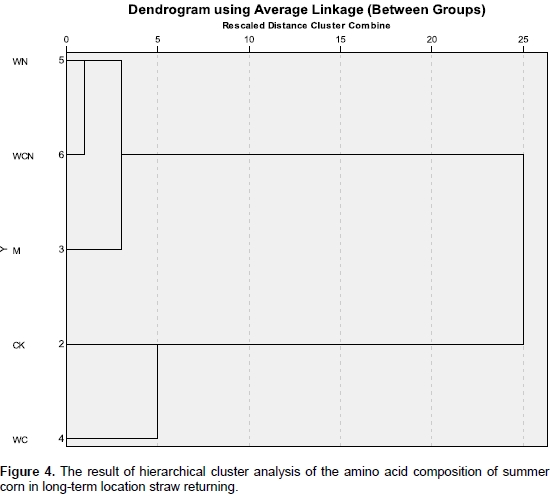
Effect of long term positioning of straw returning on the content of protein components of summer maize grain
As shown in Table 3, there were significant differences in the protein contents of maize kernel protein between different straw returning treatments. In the same application rate of nitrogen fertilizer level (WN, WCN), increasing the amount of straw returning can increase the content of HD protein, globulin, alcohol soluble protein and glutenin by 5.43, 5.64, 9.74 and 13.78%, respectively. With the increase of the amount of straw returning to the field, the histone proteins content increased significantly. In WCN processing compared to M, globulin, gliadin reduced by 24.00 and 7.14% respectively, and albumin and glutelin increased by 14.11 and 15.12% separately. In straw returning (WC) compared to straw returning combined with nitrogen fertilizer (WCN), albumin, globulin, alcohol soluble protein and glutenin content increased significantly by 90.19, 44.23, 43.47 and 53.62% respectively. It suggests that long straw returning combined with nitrogen fertilizer and organic fertilizer could increase the content of protein composition of maize grain, improve the quantity of maize, organic fertilizer and straw and other organic substances to affect protein composition.

Effect of long term positioning of straw returning on the yield of summer maize grain
As seen fin Figure 5, the application of organic fertilizer and straw returning combined with nitrogen fertilizer treatments can significantly increase the yield of maize grain. The M treatment had the highest yield of corn grain (10572.6 kg/hm2); compared to control, it increased by 210.23% and yield increase was extremely significantly. WCN processing had the second-highest yield (8442.0 kg/hm2); and compared to control treatment it increased by 143.08%. When in the same nitrogen fertilizer level (WN, WCN), WN processing maize yield was 6522.6 kg/hm2, and compared to WCN processing it decreased by 29.42%. It indicates that under the same nitrogen fertilizer level, increasing the amount of straw returning could increase the yield of maize; when in the same level of straw returning (WC and WCN), WC production was 3472.8 kg/hm2, and it reduced by 143.72% compared to WCN treatment. Under the same straw returning to the field level, increasing nitrogen fertilizer application can increase the yield of maize.
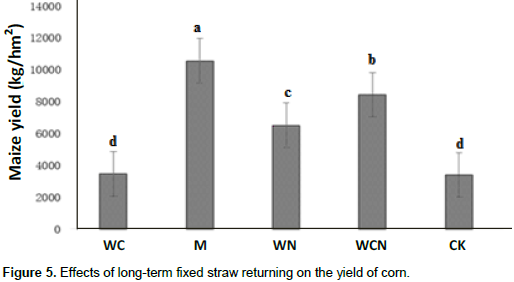
This paper is focused on the research of the long-term location straw returning to field .The following conclusions can be drawn from this experiment:
(1) Long-term single application of organic manure, straw returning and combined with nitrogen fertilizer can increase the content of crude fat, starch, protein and amino acid of maize; scientific application of organic manure, straw returning and with nitrogen fertilizer can increase maize grain quality and improve quality of maize.
(2) Organic fertilizer and straw and other organic matter influence the composition of protein components, straw returning treatment, long term application of organic manure, straw and with nitrogen fertilizer decrease the ratio of glutelin to zein of maize, and increase the content of albumin, globulin, gliadin and glutenin. Long term application of nitrogen fertilizer and organic fertilizer could increase the content of protein and improve the quality of maize.
(3) The long-term scientific and rational application of organic fertilizer, straw returning combined with nitrogen fertilizer can significantly improve the yield of summer maize.